
- •Unit 8 Historical Monuments Restoration
- •The Tower of Pisa
- •The Statue of Liberty
- •Unit 9 Unusual Architecture
- •1.1 Read the text title and hypothesize what the text is about. Write down your hypothesis.
- •What do you know concerning this issue? List your ideas in the table left column “I know”.
- •If you know answers to these questions write them down in the space given after each question.
- •Circle in the list the words and expressions you know. Write down their translation in the table and calculate the percentage of your lexical competence.
- •Unit 11 Amphibious Houses
- •1.1 Read the text title and hypothesize what the text is about. Write down your hypothesis.
- •What do you know concerning this issue? List your ideas in the table left column “I know”.
- •If you know answers to these questions write them down in the space given after each question.
- •Circle in the list the words and expressions you know. Write down their translation in the table and calculate the percentage of your lexical competence.
- •Floating Houses
- •Amphibious Architecture
- •Maritime architecture
- •Unit 16 Lattice Shells
- •1.1 Read the text title and hypothesize what the text is about. Write down your hypothesis.
- •What do you know concerning this issue? List your ideas in the table left column “I know”.
- •If you know answers to these questions write them down in the space given after each question.
- •Circle in the list the words and expressions you know. Write down their translation in the table and calculate the percentage of your lexical competence.
Unit 16 Lattice Shells
1 Introduction2 interface
1.1 Read the text title and hypothesize what the text is about. Write down your hypothesis.
…………………………………………………………………………………………………………………………………………………………………………………………………………………………………………………………………………………………………………………………………………………………………………………………………………………………………………
What do you know concerning this issue? List your ideas in the table left column “I know”.
I know that… |
I have learnt that… |
|
|
|
|
|
|
|
|
|
|
If you know answers to these questions write them down in the space given after each question.
1 |
Who built the world’s first bearing lattice shells of the overhead covers? |
|
|
2 |
What constructions are considered to be Shukhov’ masterpieces? |
|
|
3 |
What other high-tech architects implemented lattice shells into modern construction? |
|
|
4 |
Why did the construction of the Gherkin set off a debate? |
|
|
5 |
What is the largest covered square in Europe? |
|
|
6 |
What may become a new architectural symbol of the Ukrainian capital? |
|
|
7 |
sepa How many times have the architects increased the size of the traditional Pysanka? |
|
|
Circle in the list the words and expressions you know. Write down their translation in the table and calculate the percentage of your lexical competence.
1 |
creative synergy |
|
|
a spiraling well |
|
2 |
lattice shells |
|
|
a brace |
|
3 |
a breakthrough |
|
|
spectacular |
|
4 |
overhead covers |
|
|
Easter egg |
|
5 |
double curvature |
|
|
signs language |
|
6 |
a tapered body |
|
|
a central core |
|
7 |
to stand out |
|
|
light-emitting |
|
8 |
a striped pattern |
|
|
to steer |
|
S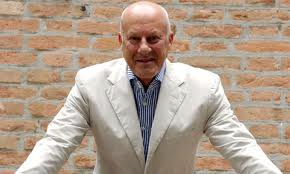 trolling
around London, tourists admire the avant-garde skyscraper "The
Gherkin" and the overhead cover of the British Museum. But only
few of them know that this delight is aroused by the creative synergy
of the two outstanding architects: the Great Russian engineer and
architect Vladimir Shukhov and the master of the high-tech
architecture Lord Norman Foster. “Shukhov is one of my heroes!” –
Norman Foster says in his interviews.
trolling
around London, tourists admire the avant-garde skyscraper "The
Gherkin" and the overhead cover of the British Museum. But only
few of them know that this delight is aroused by the creative synergy
of the two outstanding architects: the Great Russian engineer and
architect Vladimir Shukhov and the master of the high-tech
architecture Lord Norman Foster. “Shukhov is one of my heroes!” –
Norman Foster says in his interviews.
V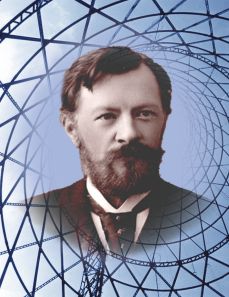 ladimir
Grigoryevich Shukhov (1853 –1939) was a Russian engineer,
scientist and architect who worked out new methods of analysis for
structural engineering that led to the breakthrough in industrial
design of world's first hyperboloid structures, lattice shell
structures, tensile structures, pipelines, boilers, ships and
bridges.
ladimir
Grigoryevich Shukhov (1853 –1939) was a Russian engineer,
scientist and architect who worked out new methods of analysis for
structural engineering that led to the breakthrough in industrial
design of world's first hyperboloid structures, lattice shell
structures, tensile structures, pipelines, boilers, ships and
bridges.
The world’s first bearing lattice shells of the overhead covers and towers were built by Vladimir Shukhov in 1896 for the biggest pre-revolution exhibition of Russia — XVI All-Russia industrial and art exhibition in Nizhniy Novgorod. Of the two steel gridshells of the exhibition pavilions one was oval in plan and the other was circular. The roofs of these pavilions were doubly curved gridshells formed entirely of a lattice of straight angle-iron and flat iron bars.
H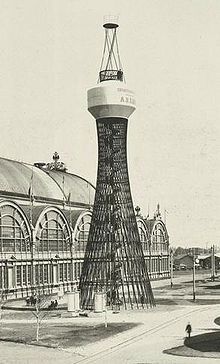 is
solution was inspired by observing the action of a woven basket
holding up a heavy weight. The astonishing hyperboloid lattice
structure caused delight of the European specialists. Shukhov himself
called them “azhurnaia bashnia” (i.e., lattice tower). The patent
of this system, for which Shukhov applied in 1895, was awarded in
1899.
is
solution was inspired by observing the action of a woven basket
holding up a heavy weight. The astonishing hyperboloid lattice
structure caused delight of the European specialists. Shukhov himself
called them “azhurnaia bashnia” (i.e., lattice tower). The patent
of this system, for which Shukhov applied in 1895, was awarded in
1899.
The attention of foreign guests was most of all drawn by the open-work lattice steel hyperboloid water tower. This world’s first hyperboloid lattice structure-shell still exists near the palace of aristocrats Nechaev in Polibino, not far from the Kulikov field.
Lord Norman Foster writes: “Vladimir Grigoryevich Shukhov was one of the greatest structural engineers of the early Twentieth Century and unquestionably the leading engineer of his era in Russia. He pioneered the use of entirely new structural systems, creating hyperboloid structures of double curvature whose lightness and geometric complexity defy the imagination, even in the computer age. The Shabolovka Tower is his masterwork. It is a structure of dazzling brilliance and great historic importance. It was the first landmark structure of the Soviet period, soaring 150 metres into the air to command the Moscow skyline. In its day, the filigree lattice structure was a pure expression of technical progress — a symbol of faith in the coming age.”
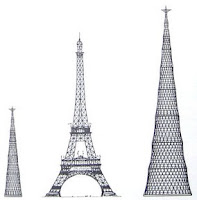
What is interesting, the Shabolovka Tower (1919 – 1922) was being built without using scaffolds and cranes. The upper sections were being assembled inside the lower one, lifted and put on each other. During more than 80 years the Shukhov Tower served as a support for large antennas of radio and television stations. Shukhov designed a 350m tower, which surpassed the Eiffel tower in height by 50m, while using less than a quarter of the amount of material.
Due to its lattice structure, the steel shell of the Shukhov Tower experiences minimum wind load. The tower sections are single-cavity hyperboloids of rotation made of straight beams, the ends of which rest against circular foundations. The round tapered body of the tower consists of 6 sections, each 25 meters high. The lower section is mounted on a concrete foundation base, 40 meters in diameter and 3 meters in depth. The elements of the tower are riveted together.
A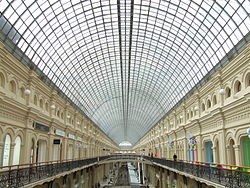 t
the end of XIX century and during the first third of XX century on
the territory of Russian Empire and USSR according to Shukhov’s
projects were built more than 250 structures. One of his masterpieces
is the roof of the Upper Trading Rows in GUM (Moscow) which still
causes admiration of thousands of people. The glass-roofed design
made the building unique at the time of construction. The roof, the
diameter of which is 46 ft (14 m), looks light, but it is a firm
construction, capable of supporting snowfall accumulation.
t
the end of XIX century and during the first third of XX century on
the territory of Russian Empire and USSR according to Shukhov’s
projects were built more than 250 structures. One of his masterpieces
is the roof of the Upper Trading Rows in GUM (Moscow) which still
causes admiration of thousands of people. The glass-roofed design
made the building unique at the time of construction. The roof, the
diameter of which is 46 ft (14 m), looks light, but it is a firm
construction, capable of supporting snowfall accumulation.
During the XX century lattice structures of bearing shells were used not enough due to the complexity of their calculation without computers. During the second half of XX century the high-tech architects, the famous Buckminster Fuller, Frei Otto, Oscar Niemeyer implemented lattice shells into the modern practice of construction. At the end of XX century – the beginning of XXI century the perfection of technologies led to the appearance of very elegant architecture, the recognized leader of which soon became Lord Norman Foster.
L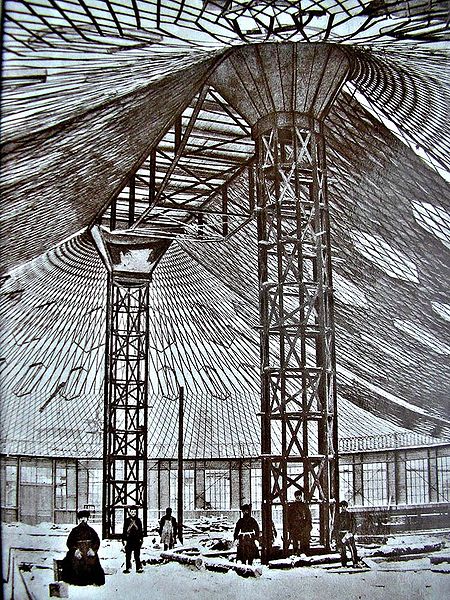
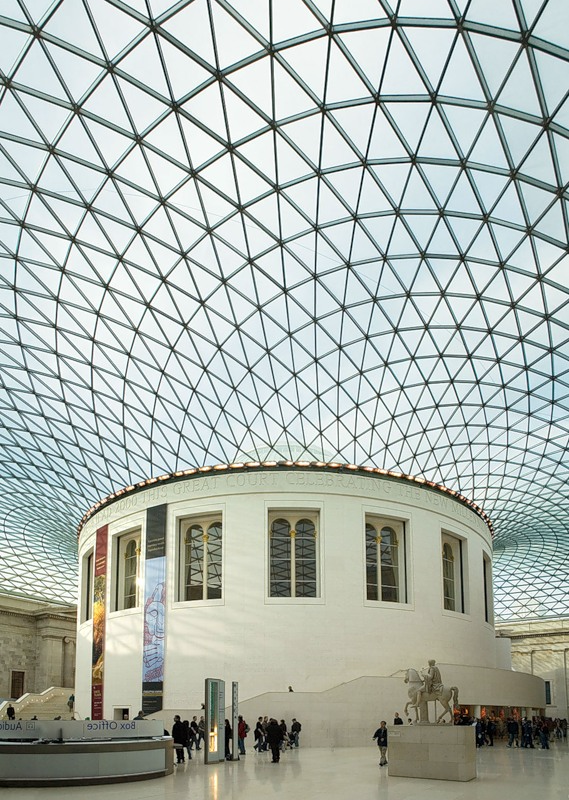 atticed
shells are extensively used by Norman Foster, developer of
such famous skyscrapers as Mary Axe in London, the dome of the
Reichstag in Berlin and the Queen Elizabeth II Great Court of the
British Museum, the largest covered square in Europe. This unique
grid shell glass and steel roof was erected over the entire courtyard
to create a covered space in the centre of the museum. The cladding
is constructed from 1,656 pairs of uniquely shaped glass panels.
atticed
shells are extensively used by Norman Foster, developer of
such famous skyscrapers as Mary Axe in London, the dome of the
Reichstag in Berlin and the Queen Elizabeth II Great Court of the
British Museum, the largest covered square in Europe. This unique
grid shell glass and steel roof was erected over the entire courtyard
to create a covered space in the centre of the museum. The cladding
is constructed from 1,656 pairs of uniquely shaped glass panels.
Compare Norman Foster’s lattice overhead covers of the British Museum with the overhead covers made by Vladimir Shukhov in 1896 in Nizhniy Novgorod (there are differences, of course, but the idea has not changed).
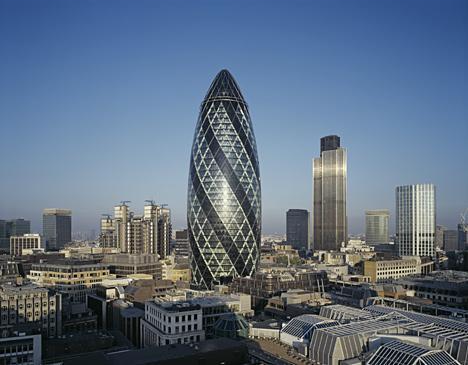
30 St Mary Axe, better known by its nickname the Gherkin (“cucumber”), is one of the most eye-catching buildings in London and it stands out prominently in the city's skyline. The 41 story tower was built in 2004 in the heart of London's financial center. The construction of a glittering high-tech building in the middle of a relatively low-rise area with plenty of historic buildings and narrow medieval streets set off a new debate about the need for tall buildings in the City of London. The Gherkin has acted as a catalyst for the growing cluster of high-rises in the City.
T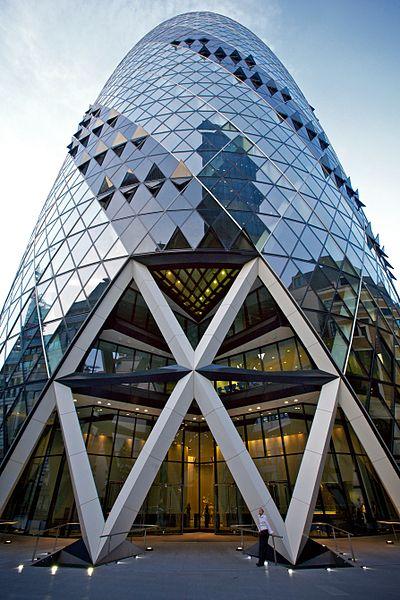 he
cigar-shaped structure has a steel frame with circular floor plans
and a glass facade with diamond-shaped panels. The swirling striped
pattern visible on the exterior is the result of the building's
energy-saving system which allows the air to flow up through
spiraling wells.
he
cigar-shaped structure has a steel frame with circular floor plans
and a glass facade with diamond-shaped panels. The swirling striped
pattern visible on the exterior is the result of the building's
energy-saving system which allows the air to flow up through
spiraling wells.
On the street level, the Gherkin's base is well integrated with an open public plaza. Huge white X braces create a dramatic entrance. The top of the tower, where visitors find an open hall covered by a glass conical dome is even more spectacular. From here you have great views over the city. Its unique, bold and energy efficient design has won the Gherkin many awards including the Stirling Prize, the London Region Award, and the Emporis Skyscraper Award.
N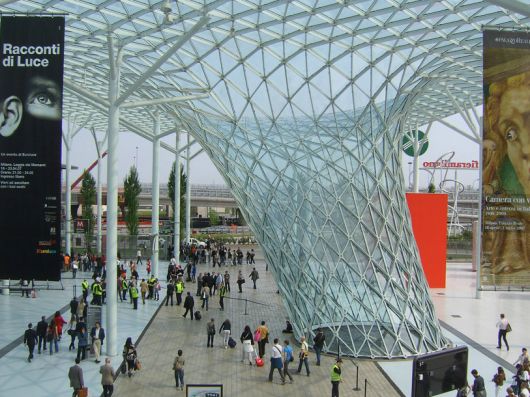 ow
lattice shells have become a creative mean of the high-tech
architecture, which pretend to dominate in the XXI century.
The famous architects Richard Rogers, Paul Andreu, Santiago
Kalatrava, Renzo Piano, Nicholas Grimshaw, Zaha Hadid, Massimiliano
Fuksas and others use lattice shells in their creative work. Now
lattice shells allow the creation of buildings with a very complex
form, including the famous Olympic stadium “Bird’s nest” in
Beijing and the amorphous complex “VELA” in Milan (right).
ow
lattice shells have become a creative mean of the high-tech
architecture, which pretend to dominate in the XXI century.
The famous architects Richard Rogers, Paul Andreu, Santiago
Kalatrava, Renzo Piano, Nicholas Grimshaw, Zaha Hadid, Massimiliano
Fuksas and others use lattice shells in their creative work. Now
lattice shells allow the creation of buildings with a very complex
form, including the famous Olympic stadium “Bird’s nest” in
Beijing and the amorphous complex “VELA” in Milan (right).
U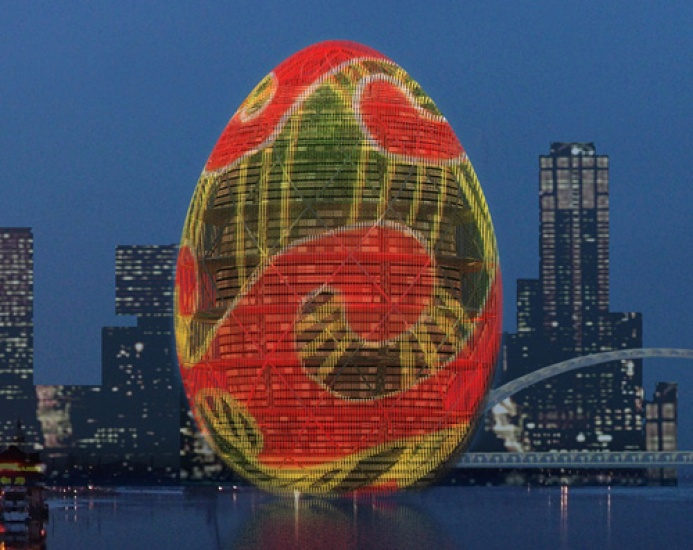 krainian
project team "ARCHIMATIKA" has developed an intricate
architectural concept - the “public complex “Pysanka”,
which could become a new architectural symbol of the Ukrainian
capital. The need for such symbolic complex is explained
by the fact that nearly all Ukrainian tourist attractions and
cultural monuments belong to historical heritage. Therefore, the
group of architects made a suggestion to build the complex in the
shape of Easter egg. Pysanka is a poetic picture of the world, which
is created by the ancient signs language of our people that can be
considered an architectural symbol of Ukraine.
krainian
project team "ARCHIMATIKA" has developed an intricate
architectural concept - the “public complex “Pysanka”,
which could become a new architectural symbol of the Ukrainian
capital. The need for such symbolic complex is explained
by the fact that nearly all Ukrainian tourist attractions and
cultural monuments belong to historical heritage. Therefore, the
group of architects made a suggestion to build the complex in the
shape of Easter egg. Pysanka is a poetic picture of the world, which
is created by the ancient signs language of our people that can be
considered an architectural symbol of Ukraine.
The architects have increased the size of the traditional Pysanka almost 44 times. Powerful lattice shell is used as the central core. The structure would house a hotel, several office levels, trade and entertainment complex, and on the upper floors - luxury penthouses.
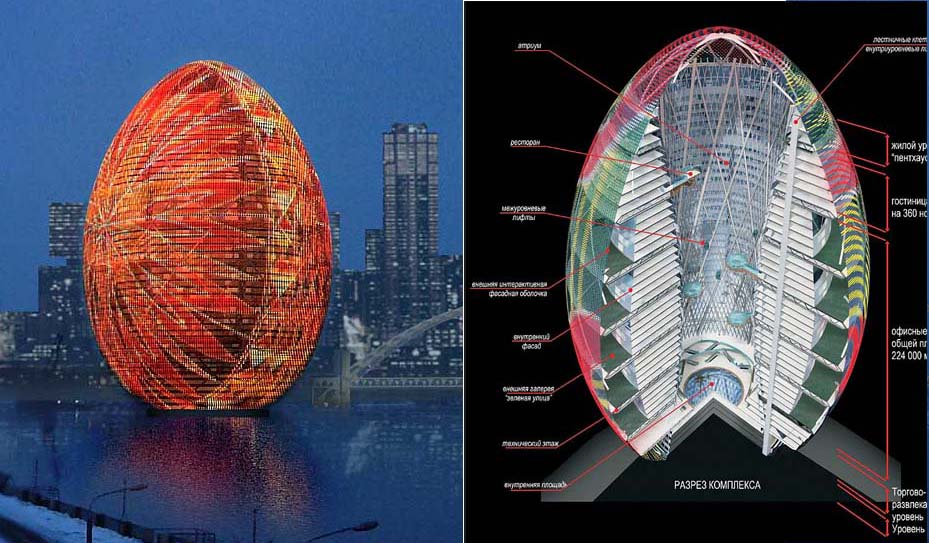
The whole exterior inter-active cover of the multi-storeyed building turns into the equivalent of a huge light-emitting diode screen that consists of 33000 separate pixels. Every pixel is a separate light-emitting diode lamp, consisting of red, green and blue light-emitting diode (RGB). The exterior inter-active cover acts like usual light-emitting diode screen. It is steered by special software. The operator can load every digital static or dynamic changing picture on the screen. It changes constantly and turns into another one. Millions of patterns of small coloured eggs are united into the big one, which varies every second but always remains the new one!
